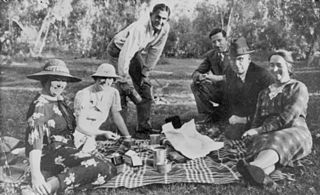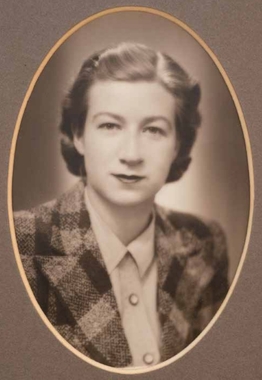
Epworth HealthCare is a not-for-profit private hospital group that provides a wide range of acute medical, surgical and rehabilitation services in Melbourne, Australia under the auspices of the Uniting Church. Epworth commenced in 1920 as a 25 bed hospital in a converted Erin Street Richmond mansion, and has expanded to now encompass multiple sites or campuses through the acquisition of other private hospitals such as the adjacent Bethesda Hospital, Cedar Court Rehabilitation Hospital in Camberwell and the Freemasons' Hospitals East Melbourne or purpose built facilities such as Epworth Eastern in Box Hill, Epworth Hawthorn Hawthorn, and Epworth Geelong Waurn Ponds, as well as a consulting suite in Lilydale.

Vera Scantlebury Brown OBE MBBS MD was an Australian medical practitioner and pediatrician in Victoria, Australia.

May Emma Campbell was a field hockey player who represented Australia in the sport from 1935 to 1948. From the tiny wheatbelt town of Moulyinning, her career spanned 50 years as a player, coach, selector and administrator in several Australian states as well as national duties. She was considered one of Western Australia's and Australia's greatest players, with Indian champion Dhyan Chand saying of her: "May Campbell is one of the finest players I have seen, man or woman."

Sir Thomas Ernest Victor Hurley, was a surgeon, medical administrator, military officer and an Australian rules footballer who played with University in the Victorian Football League.

Lilian Helen Alexander was an Australian surgeon and one of the first women to study medicine at the University of Melbourne.

Sir Thomas Peel Dunhill was an Australian thyroid surgeon and honorary surgeon to the monarchs of the United Kingdom.
Sir Hibbert Alan Stephen Newton MB MS FRCS, generally known as (Sir) Alan Newton was a noted Australian surgeon.

Hannah Mary Helen Sexton MBBS, known as Helen Sexton, was an Australian surgeon. In 1887, she led a group of seven women to successfully petition the University of Melbourne to lift their ban on women enrolling in medicine. She completed her degree in 1892, and went on to co-found the Queen Victoria Hospital. After retiring from a surgical career in Melbourne, she opened a field hospital, Hôpital Australien de Paris, in France during World War I, achieving the rank of Major in the French Army.

Salome Jean White was the first female flying medical doctor in Australia and the world when she commenced work with the Australian Inland Mission in May 1937. She was known as the Guardian Angel of the Gulf.

Nellie Constance Martyn was an Australian businesswoman who became managing director of Steel Company of Australia on her father's death. She was also a strong advocate for women and office bearer of a number of women's organisations.

Sir Henry Edward Agincourt Hodges was senior puisne judge of the Supreme Court of Victoria, Australia.

Mavis Louisa Freeman was an Australian bacteriologist and biochemist. She assisted Macfarlane Burnet in identifying the source of Q fever.

Annie Moriah Sage, was an Australian nursing administrator and Matron-In-Chief in the Second Australian Imperial Force during the Second World War. She was a recipient of the Florence Nightingale Medal, honoured as a member of the Royal Red Cross and was appointed a Commander of the Order of the British Empire.
Georgina Temperley, BA MB BS, née Bourke was an Australian medical doctor, remembered as the founder of One Woman, One Recruit, a patriotic organisation in Victoria during the Great War of 1914–1918.

Lorna Verdun Sisely, MBBS, MS, FRACS, FACS, CM was a surgeon from Victoria, Australia. She was the founder and the consultant surgeon of the Queen Victoria Medical Centre Breast Clinic, the first of its kind in Victoria. She was admitted as a fellow of the Royal Australasian College of Surgeons in 1947. She was the first woman to do this by passing the RACS Fellowship Examination. She was awarded an OBE in 1980 in recognition of her service to medicine.

Margaret Whyte MB BS was a medical doctor from Melbourne, Australia. She graduated as a doctor with the top grades in her class of 1891, and along with her classmate Clara Stone, this made them the first women to graduate as doctors in Victoria. While she qualified for a residency at the Royal Melbourne Hospital, she was denied her place because of her gender, and so took an appointment in 1892 at the Royal Women's Hospital instead. She was the first woman resident at the hospital.

Elizabeth Alice Maude O'Hara MB ChB was a doctor from Melbourne, Australia. She was one of the founding members of the Victorian Medical Women's Society, and was the first woman to take an appointment as a medical officer in the Australian Natives' Association. O'Hara was one of the first seven women to study medicine in Australia, enrolling at the University of Melbourne in 1887, and graduating in 1892.

Annie Genevieve O'Hara MB was a doctor from Melbourne, Australia who was a founding member of the Victorian Medical Women's Society, and in 1887 she was one of the first seven women who enrolled in medicine at the University of Melbourne. She graduated in 1894 and commenced practice, however, in 1897 she contracted a cold and died at 27 years of age.

The Hôpital Australien de Paris, also known as the Australian Hospital in Paris, was a French military hospital founded and staffed predominantly by Australian women during World War I.

Edith Annie Mary Alsop was an Australian artist.
















